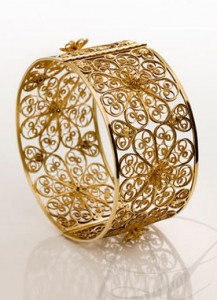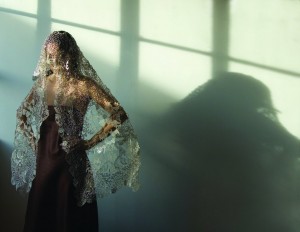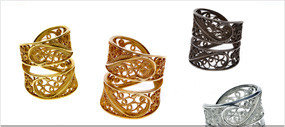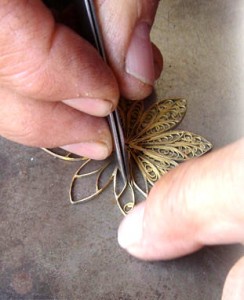
‘Sustainability’ in jewellery is not a notion frequently talked about. Though the issue of blood diamonds has been in and out of the news over the past few years, few are aware of the more far reaching consequences of raw material mining (i.e. gold, silver, copper, platinum) on the one hand, and the fact that the lion share of jewellery is produced in industrial manufacturing units, typically located in low wage, poverty ridden countries.
Arabel Lebrusan has worked throughout East Asia for over a decade and has seen with her own eyes the rather appalling working conditions in some of the factories and production sites, and the complete lack of security and hygiene. When she decided to embarked onto her own jewellery project, she was committed to adhere to the most ethical parameters possible – to the degree of giving the working conditions at suppliers the same priority as to the design of the jewellery itself. At the same time, one of her major goals is to revitalize our Occidental artisanal heritage, the rediscovery of techniques and processes that are quickly disappearing for good, and to introduce them to a new generation of consumers.
Arabel Lebrusan trained in the art of jewellery in the most prestigious European schools, and has collaborated throughout her career in projects with international companies such as Swarowski. But then, a few years ago, attracted by the narrative of the object, by its meaning beyond the aesthetic element, she decided to go her own way. Doing so implied leveraging all her experiences and her knowledge about artisanal techniques, apply them to contemporary designs, and to combine them with a strictly sustainable process.

But what is behind the rather abstract term ‘ethical jewellery’? ‘Ethical jewellery’ is jewellery that has been crafted throughout and at any stage of the process under ethical and responsible criteria. A process that encompasses materials acquisition, creative techniques and the process of creation itself.
With respect to materials, this means the use of preferably fair trade gold (and maybe one day silver), or alternatively 100% recycled gold or silver, in addition to only precious stones of certified ethical origins, and whose journey can be tracked and traced from the day it was extracted in its mine of provenance. It also means the re-discovery of traditional artisanry, and its preservation for at least one more generation through transformation and adaptation, in order to attract modern buyers. And lastly, all production processes are carried out with a deep respect for the environment and, of course, the working conditions of the workers and artisans.
For Lebrusan, the first step to engage with her customers is always to try and understand the degree to which each is familiar with the concept of sustainability in relation to jewellery. Once that they are attracted by a particular piece of jewellery, the next step is to try and educate them by providing visual information about the different stages of the creation process. They are, for instance, told that the raw material has been worked under application of strict ethical standards, or that the artisans behind each piece have a life time of experience. When it comes to the act of buying a piece of jewellery, two types of customers tend to exists: Those that know about the dark sides of the jewellery making process, and that seek to buy consciously in accordance with their knowledge. And then, the majority of customers who still remains unaware, and are simply intrigued by the design. In either case the design of a piece of jewellery features as the decisive factor at the time of a buying.

Over the centuries, Spanish filigree work has been influenced by various civilizations: the Tartessians, the Iberians, the Phoenicians, the Visigoths, and finally the Arabs whose influence took the art of filigree to new dimensions. Then, in the 16th century, filigree became popular in connection to traditional events and costumes thanks to the influence of the Catholic Church and medieval academic institutions.

But artisans like him are among the selected few who have so far managed to resist the overwhelming pressure that rests on the jewellery industry to use fast and mechanized processes. Some of the workshops that used to employ 30 or 40 skilled artisans at one time, now may only consist of the owner and possibly a small number of family members. Once they retire or required to close the workshop, all their knowledge and skills will be lost. Lebrusan hence, also engages to maintain, rediscover and adapt the traditional techniques.


